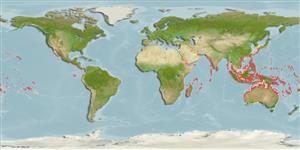>
Eupercaria/misc (Various families in series Eupercaria) >
Labridae (Wrasses) > Xyrichtyinae
Etymology: Iniistius: Latin, in = in + Greek, istion = sail.
More on author: Linnaeus.
Environment: milieu / climate zone / depth range / distribution range
Écologie
marin récifal; profondeur 2 - 30 m (Ref. 90102). Tropical
Indo-Pacific: Red Sea and East Africa to the Pacific.
Taille / Poids / Âge
Maturity: Lm ? range ? - ? cm
Max length : 25.0 cm TL mâle / non sexé; (Ref. 2334)
Description synthétique
Clés d'identification | Morphologie | Morphométrie
Épines dorsales (Total) : 9; Rayons mous dorsaux (Total) : 12; Épines anales: 3; Rayons mous anaux: 12 - 13.
Found over sandy bottoms of coastal areas and also in areas with some seagrass or algae. Ranges to a depth of over 18 m (Ref. 9710). Usually in large spread-out groups on upper slopes of sand and mud banks with males defending its section that has numerous females (Ref. 48636). Dives into sand to sleep safely at night or to hide when alarmed (Ref. 90102). When threatened, it dives head-first into sand; may take some time to emerge again. Feeds mainly on hard-shelled prey, including mollusks and crustaceans (Ref. 5374). Minimum depth taken from Ref. 9710.
Life cycle and mating behavior
Maturities | Reproduction | Spawnings | Egg(s) | Fecundities | Larves
Pelagic spawner.
Randall, J.E., G.R. Allen and R.C. Steene, 1990. Fishes of the Great Barrier Reef and Coral Sea. University of Hawaii Press, Honolulu, Hawaii. 506 p. (Ref. 2334)
Statut dans la liste rouge de l'IUCN (Ref. 130435)
Menace pour l'homme
Harmless
Utilisations par l'homme
Pêcheries: intérêt commercial mineur; Aquarium: Commercial
Outils
Articles particuliers
Télécharger en XML
Sources Internet
Estimates based on models
Preferred temperature (Ref.
123201): 24.4 - 29.3, mean 28.3 °C (based on 3300 cells).
Phylogenetic diversity index (Ref.
82804): PD
50 = 0.5000 [Uniqueness, from 0.5 = low to 2.0 = high].
Bayesian length-weight: a=0.01023 (0.00397 - 0.02640), b=3.06 (2.84 - 3.28), in cm total length, based on LWR estimates for this (Sub)family-body shape (Ref.
93245).
Niveau trophique (Ref.
69278): 3.6 ±0.50 se; based on food items.
Résilience (Ref.
120179): Milieu, temps minimum de doublement de population : 1,4 à 4,4 années (Preliminary K or Fecundity.).
Fishing Vulnerability (Ref.
59153): Low vulnerability (15 of 100).
Nutrients (Ref.
124155): Calcium = 60.7 [37.1, 98.7] mg/100g; Iron = 0.619 [0.367, 1.115] mg/100g; Protein = 18.6 [15.7, 20.8] %; Omega3 = 0.146 [0.097, 0.220] g/100g; Selenium = 25.1 [15.8, 43.5] μg/100g; VitaminA = 124 [39, 440] μg/100g; Zinc = 1.45 [1.02, 2.23] mg/100g (wet weight);
